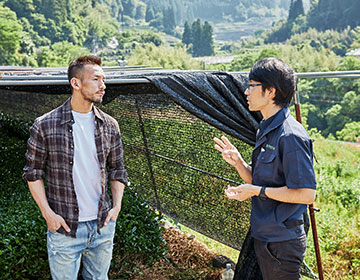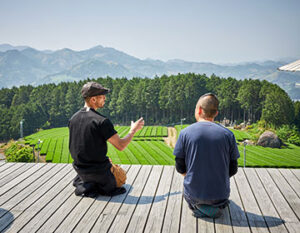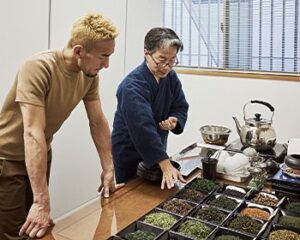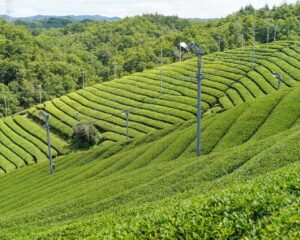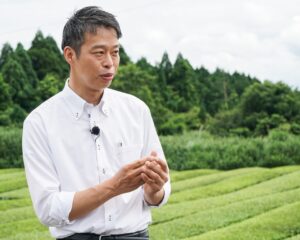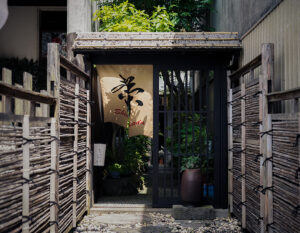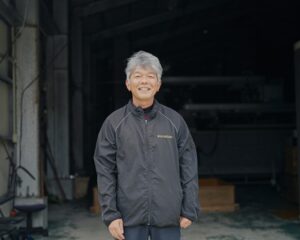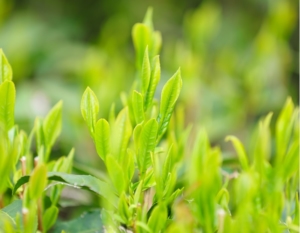In Hoshino Village, Yame City, Fukuoka Prefecture, where there is a long history of gyokuro cultivation,
this tea garden continues to produce tea with the utmost care.
While preserving the culture and traditions of tea,
we produce Japanese teas that are in tune with diversifying lifestyles!
Hoshino Village, Yame City, Fukuoka Prefecture, has long been known as a tea production area. Despite its small population of 3,000, the village has been producing tea for more than 100 years, taking advantage of the mountainous area’s unique cold temperature difference, which is ideal for tea production. Especially famous is the “Yame Traditional Hon Gyokuro” produced here. We asked Mr. Shinya Yamaguchi of Hoshino Seichaen, who was the youngest person in history to receive the “tea master 10-dan” certification at the age of 32, one of only 15 in Japan, about the appeal of this “gyokuro.
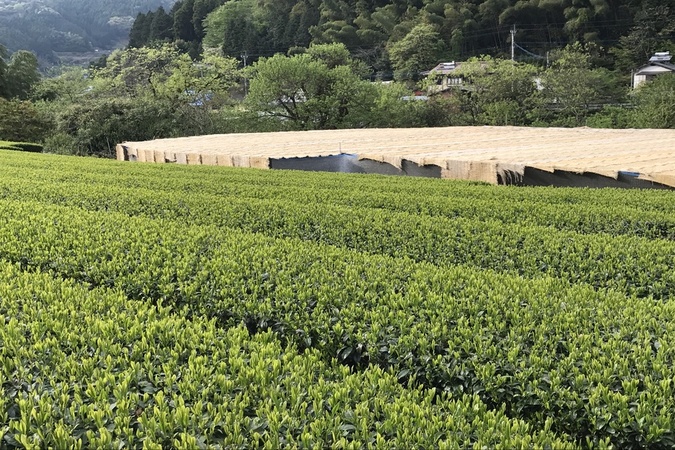
What is gyokuro?
Gyokuro is considered to be one of the finest of all Japanese teas. Surprisingly, however, the reason for this is not the variety but the cultivation method. The tea leaves are shelved around the field and covered with a straw cover (kabuse) two to three weeks before harvest to block out the sun and enhance the flavor and aroma of the tea leaves.
Among producers of gyokuro, which is renowned as one of the finest tea products, Mr. Shinya Yamaguchi of Hoshino Seichaen has been attracting attention, winning the grand prize at the Japan Tea Awards.

Became the youngest tea master in history at the age of 32 to become a “tea master Judan.
The correct term is “Jyu-dan” in tea judging technique. In the “tea judging technique competition,” participants compete in tea appraisal skills in the four judging categories of tea variety, tea season, tea production area, and tea aroma and flavor. The title ” Chashi Judan ” is given to tea masters who have obtained the highest rank of Judan. There are only 15 tea masters in Japan who hold this title, and Mr. Yamaguchi is the youngest tea professional in history at the age of 32.
The Work of a Tea Master
Currently, Mr. Yamaguchi is in charge of product quality control at Hoshino Tea Farm. First, he examines and selects tea leaves (rough tea leaves = tea leaves that have been plucked, steamed, rubbed, and dried), and carefully selects the best tea leaves. From there, the tea leaves are fired to finish the tea. The tea leaves are then fired, using a combination of shelf-type hot-air drying and direct heating, as well as far-infrared heating, to bring out the wonderful flavor and aroma from the core of the tea leaves. The tea leaves with different characteristics are blended to make products. This is called “Gokumi,” and the process of identifying and blending the tea leaves is where the tea master shows his skills.
A traditional method that has been used for 100 years
Cultivation of gyokuro is a labor-intensive process that requires extremely advanced techniques and many years of experience, as well as soil and climate suitable for cultivation. Among these, Yame, where Hoshino Village is located, accounts for more than 50% of the nation’s gyokuro production, making it the “largest producer of gyokuro in Japan.
However, it is not only the amount of production that is impressive. It is the traditional production method that has continued for 100 years in this region. In the first place, there is a clear difference in the manufacturing method between gyokuro and Yame traditional hongyokuro. In order to be called Yame traditional hon gyokuro, there are seven cultivation conditions, and only those that meet all of them can be called Yame traditional hon gyokuro. The conditions are: 1) the tea plantation must be naturally grown; 2) the cultivation must be well managed; 3) the covering must be made of straw; 4) the covering period must be at least 16 days; 5) the tea leaves must be handpicked; 6) the tea leaves must be picked at the right time to prevent hardening; and 7) the tea leaves must be grown in the right place and at the right time to prevent the leaves from being damaged. 7. The tea leaves must be carefully managed and produced without defects.
The time and effort that goes into this traditional production method , ” says Yamaguchi, ” makes it different from other teas in terms of color, aroma, and flavor.
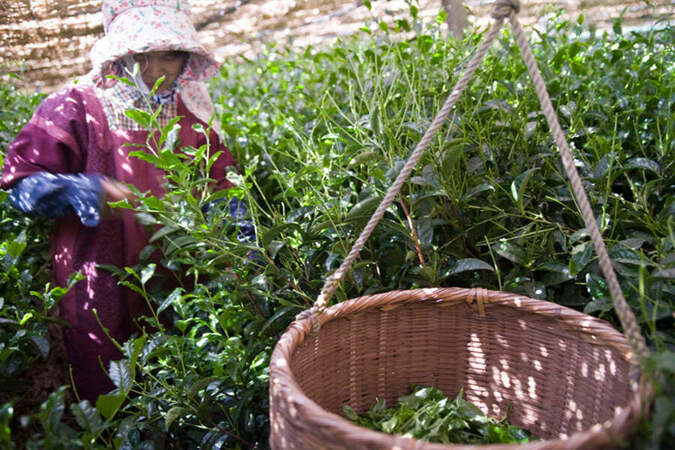
The difference in efficacy and taste of Yame Traditional Hon Gyokuro
Thus, Yame Traditional Hon Gyokuro is made by sticking to traditional techniques. Its efficacy and taste are very different from other gyokuro and Japanese teas. It is characterized by its mild umami and high richness. This is because it is rich in theanine, a type of amino acid that is a flavor component. Normally, when exposed to sunlight, theanine is decomposed and converted into catechins, which are astringent and bitter-tasting components. However, Gyokuro, which grows in almost no sunlight, is not affected by this.
Gyokuro is produced by a combination of a carefully selected manufacturing process, a favorable production area, and a producer with advanced technology and many years of experience. The Yame traditional Gyokuro that can be produced only when these three things come together is the highest quality Gyokuro that contains more flavor components than regular Gyokuro, yet has almost no astringency or bitterness, and can extract the maximum amount of Gyokuro’s original umami.
How to make delicious Yame traditional Gyokuro
As you can see from the previous methods, the method of brewing gyokuro is different from that of sencha or Japanese tea, which are generally referred to as “tea. Brew the tea in a cool water bath and pour about 20ml of the cooled water into a bowl for gyokuro tea. Put about 4 teaspoons of tea leaves in the kyusu and brew slowly for 2 to 3 minutes with the hot water from the cooled teacup, and wait for the tea to infuse. This is about the extent of drowning the tea leaves. However, this carefully brewed gyokuro conveys a robust sweetness and flavor with just a few drops in the mouth. It is rich and has no astringency or bitterness.
It has a luxurious taste. Gyokuro is not a drink to be served with meals, but rather to be enjoyed on its own for its true flavor, ” says Nakata.
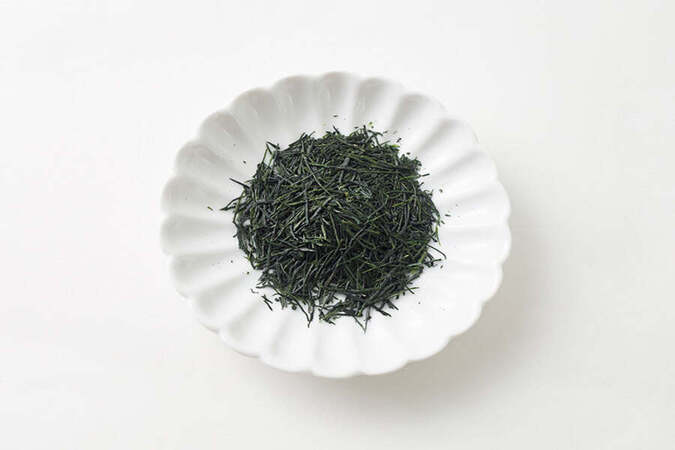
Traditions handed down through continuous innovation
As lifestyles diversify with the changing times, the needs for tea have become more diverse. Hoshino Seichaen, while cherishing the traditions of Japanese tea, is constantly challenging itself to develop further tea products that are more in tune with people’s lifestyles.
Producing matcha by applying traditional gyokuro cultivation methods. Hojicha (roasted green tea) made from the stems of gyokuro. They are also engaged in the production of teas other than gyokuro and the development of processed tea products, such as hojicha, which uses the stems of gyokuro.
We will continue to pass on the culture and authentic taste of tea, which is the pride of Japan, by pursuing the possibilities of tea and continuing to innovate to meet ever-changing tastes, ” said Yamaguchi. says Mr. Yamaguchi.
We cannot take our eyes off of the future of Hoshino Seichaen, which will spare no effort to preserve and further pursue Japan’s unique “tea” culture. Hoshino Seichaen’s products are available at their stores and online store.
Hoshino Seichaen employs many Japanese tea instructors and advisors, including a tea master with the rank of “tea judging technique 10th dan,” also known as “tea master 10th dan. From among the many varieties of tea available, we will introduce you to delicious teas that meet your taste preferences, intended use, and other requirements. Please feel free to consult with us.




